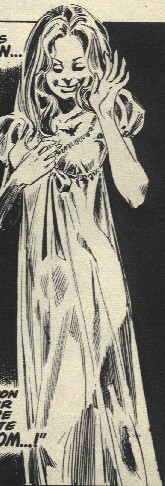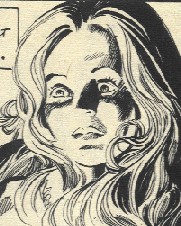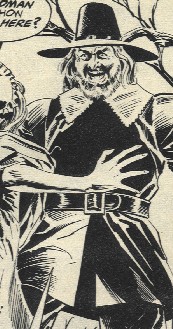 CHARITY
BROWN
CHARITY
BROWN
 CHARITY
BROWN
CHARITY
BROWN
Real Name: Charity Brown
Identity/Class: Human (17th Century)
Occupation: Laborer
Group Membership: None
Affiliations: Would-be lover of Dracula;
former ward of Goodman Miles Alden
Enemies: Miles Alden
Known Relatives: None
Aliases: None
Base of Operations: Salem, Massachusetts, @ 1691
First Appearance: Dracula Lives#1 (1973)
Powers/Abilities: Charity had no special powers or abilities, though she soft, beautiful, and gentle.
 History:
History:
(Dracula Lives#1/2 (fb) - BTS) - In 1681, Charity's parents died,
and she was taken in by Goodman Alden, serving as his ward and
laboring for him to earn her keep.
(Dracula Lives#1/2) <1692> - Tiring of the wanton harlots he had turned into his Brides and wanting a bride more like his beloved Maria, who would come to him willingly, Dracula sent out a mental call across the planet. His call was heard by Charity, who responded with interest. Intrigued with her virtue and genuine desire to be his mate, Dracula marked Charity's pure white bosom with his sign (a bat). He then made rapid preparation to travel to the USA to meet her, by horse and carriage and then by ship.
Delighted at the prospect of her soon-to-be lover, Charity danced under the moonlight. Her movements (and preceding conversation--at least her side of it) were observed by Goodman Alden, whose own desire was roused by her sensual movements in her thin night gown. Alden approached Charity and tried to sample her favors, but she fought back against him, ultimately using a branch to fight him off. Infuriated at this rebuke, Alden vowed that if he couldn't have her that no one would.
Back in the village, Alden spread word of Charity's dealings with "the devil," and of the "witch's mark" upon her bosom. A mob assaulted Charity and dragged her off to a jail cell. A speedy (and shameful) trial named her as guilty, and Charity was hanged and killed. Dracula arrived mere minutes too late to save her, but he did see as Alden taunted her and claimed responsibility for her death. Dracula slew Alden, but blamed the entire village and decided that all of Salem must may the price. To this end he bit and ensorcelled a young woman, Tituba, telling her to wait 12 months so the town could forget its shame, and then to wreak vengeance on the village, as he had instructed.
Comments: Created by Roy Thomas, Alan Weiss, and Dick Giordiano.
As noted in the text feature of the history of Marvel's Dracula in Tomb of Dracula II#3/2, Charity Brown was the first woman for which Dracula felt legitimate emotion since Maria, over two centuries earlier. It was after this that he began to see female targets in a more sensual light, more than just food/prey.
In MTU#42 Tituba seems old, but this could
be a collateral effect of the vampire's bite. John Proctor says she was a slave
who arrived in 1691 from the Barbados, but this does not fit with what happened
in Dracula Lives#1/2 where it is said she lived in Salem from youth.
--Spidermay
Marvel Team-Up Index declared that the Salem seen in that MTU
story was that of an alternate Earth due to the time travel involved, and that
therefore that was not the same Tituba as seen in Dracula Lives!
--Per Degaton
I give this some credence since it is from an Official Index,
but the rules of time travel are not hard and fast. They vary with author, etc.
Generally, I think that it is possible to travel to the past with time machines.
Sometimes actions taken by time travels can affect the past (or, more
accurately, those events had actually occurred in the past, they just had not
been previously revealed). Sometimes past actions actually do change the
present. Most often, changes in the past diverge a new timeline.
The way I see it is if the Dark Rider was revealed as the
orchestrator of the Salem Witch Trials and the outcome was the same as prior to
this information being revealed, it does not have to be an alternate timeline.
--Snood
Further witch trials stories can be found in the New
Warriors' Time and Time Again storyline in which a time travelling Firestar met
Agatha Harkness in Salem.
SALEM WITCH TRIALS
Here's a series of nice websites with good info on the Salem Witch Trials, specifically Tituba's involvement, in the real world, courtesy of Joe Littrell:
Tituba
Written By Alyssa BarillariSalem Witch Trials in History and Literature
An Undergraduate Course, University of Virginia
Spring Semester 2001
In late February of 1692, Reverend Samuel Parris called in a doctor to examine his nine-year-old daughter, Betty, and eleven-year-old niece, Abigail Williams-both of whom were suffering from spontaneous fits. The children were soon diagnosed as victims of witchcraft, setting off an outbreak of panic and hysteria, which would sweep throughout Salem Village and its neighboring towns that year. Historians have long pointed the collective finger of blame at the Parris's slave, Tituba, one of the three women first accused of witchcraft, and the only member of this unfortunate trio to survive the year.
Many interpretations of the Salem Trials acknowledge the pivotal role Tituba's confession played in legitimizing the early suspicions and subsequent investigations of witchcraft, seizing on the vivid descriptions of the devil and his minions that she provided to the examining justices. A number of sources also assert that Tituba also introduced supernatural ideas to the "afflicted girls." These scholars claim Reverend Parris had purchased her in Barbados, unaware of the voodoo and witchcraft practices she would eventually undertake under the roof of the Salem parsonage.
However, the mantle of guilt so eagerly thrust upon Tituba may not be rightfully hers (and at the very least, not hers alone). Later investigations have only raised more questions about the very little verifiable information available on her. Most of the perceptions and understandings of Tituba, today commonly accepted as fact, are actually based on local tradition and fictional literature rather than actual court documents or eye-witness accounts. Admittedly, the legend of Tituba as the "Black Witch of Salem" (a posthumous appellation which immediately suggests interesting racial and class connotations) may be more mysterious and entertaining than the accurate historical extent of her influence on the Salem trials; nevertheless, the ways in which this myth has been constructed are fascinating as well.
In all of the court documents relating to the Witchcraft Trials, Tituba's identity is listed as that of an "Indian Woman, servant" (for example, Warrant vs. Tituba and Sarah Osborne -SWP 745). But as scholars have recently pointed out, somewhere in the development of the Salem lore, Tituba's racial heritage has been transformed and confused-thus she appears in texts variously as "Negro," "half-breed," "colored," or "half-Indian, half-Negro." Assumptions about her origins range from the island of Barbados to Africa to Native American. This confusion necessarily complicates any understanding of the consequential and critical part traditionally assigned to Tituba; we must consider how racial stereotypes and presumptions have contributed to the varying amounts of blame she is forced to bear.
Truthfully, Tituba's story may never be clearly sorted out. Her status as a slave constrains any attempts to uncover official records and papers relating to her. The little glimpse of her life that is available is provided only by the court transcripts themselves. Though Tituba's words may resonate to us through the court records, she cannot tell her version of the events leading up to the Trials, she cannot share her own history and memory of Salem and life before it. In addition to Tituba's own recorded words, we can obtain some information based on what her contemporaries said of her. Beyond these strict limitations however, we can realistically draw no further conclusions as to her racial identity, affinity for witchcraft and stories of the occult, nor motivations for confessing to the accusations.
What we do know is from the historical documents is that Tituba was in fact a slave in the Parris home at the time of Betty and Abigail's initial sufferings. Tradition holds that she was married to another slave, John Indian, and the couple was purchased by Reverend Parris during time he spent in Barbados. Tradition, however, does not a history make. Tituba and John Indian did reside with the Parrises; Samuel Parris had a plantation in Barbados, and he owned two slaves after he returned to Boston, and she could have come from Barbados. However, the story that Tituba struck the "fatal spark" and ignited simmering tensions in Salem Village by enthralling the local teenage girls with her stories of African or Caribbean voodoo and magic spells must be recognized for what it is --a story. It was not her "voodoo spells and stories" which, in fact, caused the girls' initial hysterics but their practice of forbidden fortune telling.
Nowhere in the court records or contemporary accounts is Tituba said to have taught the practice of fortune telling to the girls in Rev Parris' house. The fortune telling technique that the girls' used, as reported by one of them to the Rev. John Hale, was an egg white in a glass of water. This was a commonly known device in New England at the time, and it was condemned by the Puritans as a demonic practice. According to the Rev. Hale, one of the girls saw a "specter in the likeness of a coffin" in the glass, and she and another girl fell into fits. Tituba did not confess to the teaching of fortune telling; she confessed to signing the Devil's book, flying in the air upon a pole, seeing a cats wolves, birds, and dogs, and pinching or choking some of the "afflicted" girls. She also said she was beaten by her owner, Rev. Parris, and was told to confess to witchcraft, which she did -- and what she confessed to was all culturally European, not African or Caribbean.
Tituba's confession, however, did ignite a "spark" in the court, especially when she named the other accused witches, Good and Osborne, as her accomplices. Confession is what the judges were looking for, and Tituba's "evidence" of a conspiracy of witches in Salem Village stimulated the court and the girls to find and convict more people.Bibliography
Bernard Rosenthal, Salem Story, 1997.
"Tituba's Story," New england Quarterly, Vol. 71, No. 2 (1998).
Firestar time traveled back to the Salem
Witch Trials during the Time and Time Again crossover:
New Warriors #47 "Like Flies In Amber"
Time And Time Again Part 1
Nova #6 "Which Hunt" Time And Time Again
Part 3
Nova #7 "Which Hunt Act II" Time And Time
Again Part 6
--Per Degaton and Kyle Smith.
Actually, TV has three opinions on witches/wiccans.
They're either an evolutionary off-shoot of humanity (Samantha,
Tabitha, Sabrina...), Satanists (check out any horror movie with
witches) or (this is the most accurate version) Wiccans like The
Halliwell Sisters on Charmed and Angelique Collins on Dark
Shadows.
--Will U
Almost every comic I've seen them in makes the
the 2nd type listed above, Satanists. In reality, I'm agreement
with Will (I ASSume since I've never seen either of the shows he
mentioned), that they are more of just an Earthy, Gaea-worshipping
society. I'd be happy to include further real world descriptions
if anyone has anything worth contributing. I've known a few
Wiccans, and I'll let you know when I find one that is evil or a
devil-worshipper.
--Snood
CLARIFICATIONS:
No known connection to:
 Goodman Miles Alden
Goodman Miles Alden
A respected landowner, he adopted Charity in
1681 after her parents were killed in a fire. Over the years he
was well aware of the changes she was undergoing as she developed
into a woman. He followed her out into the night air in 1691 and
observed her conversation with Dracula (though he thought it to
be the devil) and her subsequent frolic in the moonlight.
Overcome with desire, he attempted to take her, but she fought
back and fled him. Furious, he revealed her actions and her mark
to the townspeople, and she was soon sentenced to death as a
witch. After her death, but while she was still swinging from the
hangman's noose, Alden taunted her, saying that the devil was now
the only one with whom she could share her kisses. However, he
then encountered the enraged Dracula who told him: "You
asked for the devil. He was too busy stoking his fires in Europe--but
he sent me in his stead!!"
Dracula then shattered Alden's spine, killing
him.
--Dracula Lives#1/2 (1/2 (fb) - BTS, 1/2
(Dracula Lives#1/2) - Taken from the islands <of Barbados> as a young girl, she lived as a slave in Salem, cooking and caring for her master's children. Dracula found her in 1691 and chose her as the instrument of his vengeance for Salem, for killing his would-be bride. Biting Tituba, he then bent her will to his and told her to wait for 12 months and then to follow his instructions.
Dracula's instructions led Tituba to orchestrate the events that culminated in the Salem Witch Trials.
(Marvel Team-Up I#42 (fb)) - In
the winter between 1691 and 1692, in Salem, Tituba served as cook in Reverend
Samuel Parris' home. She attracted Betty Parris and her cousin Abigail teaching
them Black Magic. The two girls and Mary Walcott learnt to use a puppet and a
SPILLONE (needle?) to harm Ms. Sarah Good. Later their actions drove Salem to
the witchhunt causing unjustified deaths and despair, helped by the actions of
Cotton Mather, pawn of the Dark Rider.
--Dracula Lives#1/2 (Marvel Team-Up I#42 (fb)
Appearances:
Dracula Lives#1 (1973) - Roy Thomas (writer/editor), Alan Weiss (pencils), Dick Giordano (inks)
Marvel Team-Up I#42 (February, 1976) - Bill Mantlo (writer), Sal Buscema (pencils), Mike Esposito & Dave Hunt (inks), Marv Wolfman (editor)
Last updated: 12/14/05
Any Additions/Corrections? please let me know.
Non-Marvel Copyright info
All other characters mentioned or pictured are ™ and
© 1941-2099 Marvel Characters, Inc. All Rights Reserved. If you
like this stuff, you should check out the real thing!
Please visit The Marvel Official Site at: http://www.marvel.com
Special Thanks to www.g-mart.com for hosting the Appendix, Master List, etc.!